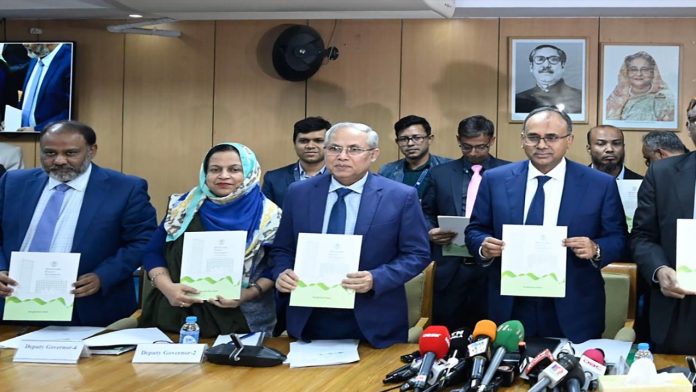
In an inflationary environment, unevenly rising prices inevitably reduce the purchasing power of some consumers, and this erosion of real income is the single biggest cost of inflation. Inflation can also distort purchasing power over time for recipients and payers of fixed interest rates.
Actually, the government is preparing plans for settling the debt liabilities, interest and exchange rates, and prepares a comprehensive reform approach to overhaul the financial system and increase the revenue mobilization.
“Inflation has been very high for a long time. Many people, particularly the poor and those with a fixed income are suffering. The balance of payment issue is complicating inflation management,” governor said.
Explaining the rising inflation, he said the rate began to increase in the post-Covid period amid supply chain disruption and the problem further worsened due to commodity price shocks owing to the Ukraine-Russia war.
However, inadequate domestic policy response in a timely manner is also equally or more responsible for the degradation of the situation, he added.
For a long time, the Bangladesh Bank had hoped that a positive supply response would take care of the inflation. But their fight against inflation remained virtually unattended except fixing the interest rate, governor said.
Bangladesh’s annual inflation rate eased to 9.4% in December 2023 from 9.5% in the previous month, marking the lowest reading since April last year. Prices rose at a softer pace for clothing & footwear (8.5% vs 8.9%), furnishings & household equipment (13.3% vs 14.1%), transportation (6% vs 6.1%) and recreation & culture (15.6% vs 15.9%). Food inflation also posted the least rise in seven months (9.6% vs 10.8%). Conversely, inflation accelerated for housing & utilities (10.6% vs 10.2%). On a monthly basis, consumer prices declined 0.6% in December, following a 1% fall in November.
The new monetary policy was unveiled by Bangladesh Bank Governor Abdur Rouf Talukder during a press conference held at the Bangladesh Bank headquarters yesterday while the central bank’s chief economist Md Habibur Rahman made a presentation on it.
Governor Abdur Rouf Talukder emphasised the inadequacy of the previous target-based policy in containing inflation, leading to the decision to shift toward a lending rate-targeting-based policy.
He said despite import restrictions, huge amounts of luxurious cars were imported which reflects that money was cheap due to the lending rate cap. In this perspective, the central bank moved to lend rate targeting-based policy making money expensive removing the lending rate cap, he added.
He said imposing a lending rate cap was a political decision and removing the cap is also political as the central bank convinced the government that this cap is not good in the current economic situation.
In the new monetary policy, Bangladesh Bank introduced a market-driven reference lending rate for all types of bank loans, replacing the lending rate cap that was imposed in April 2020.
“This move aims to enhance competitiveness in the banking sector and foster a favourable lending environment for businesses and individuals,” says the monetary policy statement.
The reference lending rate, known as “SMART” (six-month moving average rate of Treasury bill), will be announced monthly through the Bangladesh Bank’s website, with a margin applied for banks and non-bank financial institutions (NBFIs). In practice, SMART plus a margin of up to 3% will be applicable for banks and SMART plus a margin of up to 5% will be applicable for NBFIs.
However, the lending activities for CMSMEs and consumer loans may be subject to an additional fee of up to 1% to cover supervision costs and there will be no changes in the interest rates applicable to credit card loans. The new lending rate formula will come into effect on 1 July this year.
At present, the six-month Treasury bill rate is 7.1%, and following the new formula new lending rate will be a maximum of 10.1% for banks and 12.1% for NBFIs.
Moreover, in line with the tight monetary policy stance, the Bangladesh Bank has decided to increase policy rates. The repo rate, also known as the policy rate, will rise from 6% to 6.50%, accompanied by a ±200 basis points symmetric corridor consisting of an 8.50% repo rate. Furthermore, the reverse repo rate will increase from 4.25% to 4.50% effective from 1 July 2023.
Under this new framework, the interbank call money rate will closely align with the policy rate, ensuring stability.
“This measure aims to raise the cost of borrowing, which is expected to have a limiting impact on CPI inflation,” says the monetary statement.
The Bangladesh Bank will adopt a unified and market-driven single exchange rate regime, allowing the exchange rate between taka and US dollars or any other foreign currency to be determined by market forces. BB wills are no longer quote specific rates for buying or selling foreign exchanges, promoting stability in the foreign exchange market, it adds.
“Lastly, BB will calculate and publish gross international reserves (GIR) in line with the sixth edition of the IMF’s Balance of Payments and International Investment Position Manual (BPM6) while keeping track of current practices of calculating and reporting total foreign assets.”
At present, the Bangladesh Bank has a gross foreign exchange reserve of $29.77 billion as of 7 June. However, the central bank will have to exclude some components worth nearly $8 billion from this figure.
As per BPM6, the central bank will have to calculate this gross reserve excluding foreign currency loans to local banks known as the Export Development Fund (EDF), deposits with state-owned local banks, deposits with IDB Group, fixed-income securities below investment grade, a loan to Sri Lanka and other foreign currency assets in non-convertible currencies.
Moreover, the central bank will have to calculate the net reserve excluding liabilities from the gross reserve. At present, Bangladesh Bank has liabilities to the tune of nearly $4 billion. If the new formula is applied, the net reserve of the Bangladesh Bank stands below $20 billion.
The IMF set the floor on net reserves at $24.46 billion for June – when the lender will conduct the first review of the performance criteria of the central bank for releasing the second tranche of the $4.7 billion loan package. However, the Bangladesh Bank decided not to disclose net reserves.
The Bangladesh Bank governor stated that failing to build the net reserves to meet the IMF ceiling is not a significant concern.
He emphasised that it is more important for the central bank to fulfil its payment obligations rather than simply accumulating reserves to adhere to the IMF’s requirements.
The governor expressed confidence in the central bank’s ability to convince the IMF if the net reserve ceiling cannot be maintained.
He further acknowledged that exchange rate and reserve management would pose significant challenges for the Bangladesh Bank in the coming fiscal year.
When the Bangladesh Bank unveiled the outgoing monetary policy in January, the impacts of the Russia-Ukraine war on global supplies and prices were already full-blown. Inflation was creeping and the foreign exchange market was turning volatile fast.
Even then, many macroeconomic indicators were stronger than those of today; foreign reserves were bigger, and private sector credit growth was higher.
Six months later, the situation has now turned from bad to worse, and containing inflation still remains the “first and foremost” objective of the central bank’s new monetary policy statement released on Sunday.
“Rising inflation and sustained exchange rate pressures continue to pose significant challenges for the Bangladesh economy,” it said, also identifying high non-performing loans and depleting reserves as key challenges for the first half of the next fiscal year (FY24).
To tame inflation, which approaches double-digit, the central bank says its strategy “will be to reduce the aggregate demand in the economy while continuing the supply-side interventions.”
It will pursue a contractionary monetary policy stance accompanied by specific policy initiatives to maintain a stable and favourable business environment, according to its new Monetary Policy Statement (MPS).
The central bank explained why its current monetary policy stance did not help stop inflation from roaring.
These include higher prices of imported items in the global market and a larger depreciation of the taka, coupled with upward adjustments in fuel and energy prices have significantly contributed to elevated domestic commodity prices and inflation, it said.
“The lack of a competitive environment, along with market syndication, could have also contributed to the current CPI inflation,” it said, pointing out that non-food inflation was greater compared to food inflation.
The central bank however believes the policy measures taken in the new MPS would work if global factors improve– if major economies pause the rate hike race, the environment remains pandemic-free and war-related disruptions normalise.
“Given the favourable developments of these factors, BB aims to tackle inflation and exchange rate pressures while fostering a stable and resilient macroeconomic environment,” it reads.
When Moody’s downgraded the rating on both the banking sector and credit rating on Bangladesh, the central bank projects that the financial account will turn to a surplus of $3.5 billion in FY24 riding on remittance inflow.
The financial account turned negative above $2 billion in July-April and the Bangladesh Bank estimated that it will be $3.5 billion at the end of FY23.
The central bank governor said that Moody’s downgrading does not have an impact on foreign direct investment or remittance inflows to Bangladesh.
He termed Moody’s rating as more geopolitical than economic, and said, “Those who are involved in investing or sending remittances to the country are well aware of our economic background, and they will continue to do so based on that understanding.”
Earlier, in March 2023, Moody’s revised the outlook on Bangladesh’s banking system to negative from stable.
Later in May, it downgraded the credit rating of Bangladesh due to heightening external vulnerability and liquidity risks amid a deterioration in foreign exchange reserves, which indicates continued pressure on Bangladesh’s external position, exacerbating import constraints, and, as a result, energy shortages.
The central bank governor said the current state of Bangladesh’s economy is significantly better than it was in 2010.
He stated that despite significant growth in Bangladesh’s economy, including an increase in per capita income and foreign reserves exceeding $48 billion – compared to $10 billion in 2012 when Moody’s first rated the country – Moody’s has not revised its rating.
The governor said that the export realisation value is more than $2 billion short of the shipment value due to a time lag of six months.
“Exporters deliberately made some delay (in bringing in proceeds). They thought if they bring it after a month, then the currency will devalue a little and they will gain a little. In order not to let this behaviour continue, we have made a rule that no matter how many days after the 180th day the export proceeds come the exporters will get the proceeds at the 180th day’s exchange rate. There was an incentive, it’s gone now. So, we think the export proceeds will come within 180 days.”
According to the Balance of Payment statement, trade credit became negative $3.6 billion in July-April of the current fiscal year which was negative $1.1 billion in the same period of the last year.The widening gap in trade credit put pressure on financial accounts as it reflects that export proceeds repatriation has been declining.







